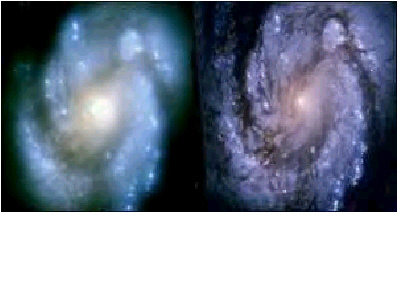|
3) Seventeen centuries, Huygen's Principle and the law of refraction:
To explain refraction and reflection, Huygen presented the light as a wave front. The
application of Huygen's principle to refraction requires that if a light ray is bent toward the
normal in passing from air to an optically dense medium then the speed of light in that optically
dense medium 'glass' must be less than that in air.
The theory is the same for the reflection of a plane wave. (Ref. Halliday - Resnick page 1020 )
4) Proposed theory in the past :
In the pass some represented the light travelling as if the source was a machine-gun sending
projectiles. The theory felt short of explaining the phenomenon of refraction and was dropped.
B- NOW WE WILL IMAGINE A MODE OF PROPAGATION THAT INCLUDES ALL OF WHAT WE HAVE DISCUSS SO
FAR.
1) The model description
Instead of a machine-gun think of a contingent of soldiers who fire under the order of a
commandant. We would have wave of projectile made up of photons. The model would fit the law of
refraction and reflection as presented by Huygen. See the diagram below, the wave and photons
trajectories are shown as lines.
Now we have to explain what happens when the photons hit an optically dense medium surface.
From what we already discuss the energy is absorbed by the electrons from first atoms layers.
In turn the electron emit electromagnetic energy to the next layer of atoms..
Display diagram ( Particles wave/refraction)

"Particles wave theory/refraction">
2) Analogy to Planck's theory
They react as Planck described it, they behave like tiny electromagnetic oscillators. The
oscillators emit electromagnetic energy into the next layer and absorb it from previous one.
If we can see through glass, it is not that the photons travel across the glass. The
electromagnetic energy is first absorbed and than transmitted from layers to layers. From other
research source we understand that the electrons spin capture the information and release it to
the next stage.
(voir réf:) the properties
of the photons are transferred to the atoms
3) The model behaviour in refraction and reflection
At Each impact point the photon is absorbed and when transmitted become a point source of light
to reform the wave as shown in the diagram.
Depending on the type of material, the atoms surface electrons will absorb the energy. Now the
energy can be directed trough the body as in refraction, send back as in reflection or
transformed into heat for black body.
4) Einstein's constant "c"
We can now define Einstein's constant "c" the speed of light. The atom electrons emit
electromagnetic energy in accordance to quantum physic. The photon carries a fixed amount of
energy in a concentrated bundle. The photon is always emitted at the constant speed "c"
relatively to the atom itself
Now we can see why Michelson always measured the same speed for the light. A measuring
instruments will always give the speed of light in relation to its own atoms at 300 000 km/sec.
5) Instruments that measure the true speed of light
The only way to measure the true incoming speed is by using the reflection principle on a
curved mirror in space. We use in this article Hubble telescope.
The incident light must impact the mirror prior from touching anything. If it hit something
before the mirror, the speed of light would become 300 000 km/sec in relation to the object it
struck.
We can calculate the speed of the incident light from the change in the mirror focal length.
We could also use a lens in refraction, we would obtain the same effect.
6) Michelson's experience explanations.
Ref.#5 expériences faites par Michelson et Morley
If we apply the theory to Michelson's experience, we see that the two light rays come back at
the same speed and without a phase change.
The analogy is of two swimmer in a pool on a boat. One swims in the way of the boat the other
across. The relative speed between the swimmers is independent of the speed of the boat. Again
that illustration explain why Michelson did not see a difference in his experimentation.
No Einstein theory of relativity is not necessary to explain the observation done on the speed
of light. We can explain what happens with classic physic. The KISS principle hold true here
Keep It Simple.
| 

